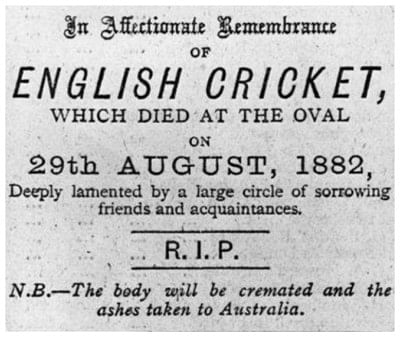The embers still burn

The ultimate form of cricket Tests -- is also the most primitive. Since the 19th century, it has enthralled millions and on July 21 this year, the 2000th Test match will be held at its spiritual home Lord's. The Daily Star Sport pays tribute to Test cricket and over the next 39 days will take you on a journey spanning 134 years.
Although Test cricket has now grown to include ten nations, in the beginning, back in the 19th century, it was only England and Australia who fought for cricketing supremacy. The Ashes, the trophy they still fight for, is one steeped in tradition. On the face of it, it's a small, almost inconsequential trinket, but perhaps for this very reason cricket-lovers are drawn to its origins.
The popularly believed version of the story is well-known among cricket faithfuls. In the summer of 1882, the Australian team under the captaincy of Billy Murdoch visited England to play one Test match at the Oval. It was the ninth Test ever played and in their previous visits, Australia failed to notch a win over the mother country.
On their tour that year, the Australians played just one Test at The Oval in London. It was a low-scoring affair on a difficult wicket. Australia made a mere 63 runs in their first innings, and England, led by AN Hornby, took a 38-run lead with a total of 101. In their second innings, the Australians, boosted by a spectacular run-a-minute 55 from Hugh Massie, managed 122, which left England only 85 runs to win.
But Fred 'Demon' Spofforth, Australia's fearsome fast bowler at the time, had other ideas. He devastated the English batting, taking his final four wickets for only two runs to leave England just eight runs short of victory in one of the closest finishes in cricket history of all time.
All of England were shocked to witness the first defeat at home at the hands of a mere colony.
The following day, a journalist named Reginald Shirley Brooks ran a mock obituary in the Sporting Times: "In Affectionate Remembrance of ENGLISH CRICKET, which died at the Oval on 29th AUGUST, 1882, Deeply lamented by a large circle of sorrowing friends and acquaintances R.I.P. N.B. The body will be cremated and the ashes taken to Australia."
This laid the catalyst of the Ashes legend.
That winter, when Ivo Bligh, later Lord Darnley, led a team to Australia, he promised to bring back the ashes. As per his word, England won the second and third Tests of the series to take a 2-1 lead, and a group of Melbourne ladies presented an urn to him that supposedly contained the ashes of the bail used in the third Test. That is what the world knew of the origins of cricket's oldest trophy. The legend, however, took a romantic turn at the end of the 20th century.
Among the group of ladies that presented Ivo Bligh the urn was his future wife Florence Morphy. In April 1998, Rosemary, Dowager Countess of Darnley, claimed that Morphy, her mother-in-law, had told her in secret that the urn contained the ashes of a veil that she was wearing when watching the visiting England side play in Melbourne in 1883.
She burnt her veil to get the attention of the England Captain and her future husband, Bligh.
A bail or veil has hardly mattered for the cricketers and the public of the two nations who rate this Test series as the ultimate competition.

 For all latest news, follow The Daily Star's Google News channel.
For all latest news, follow The Daily Star's Google News channel. 




Comments